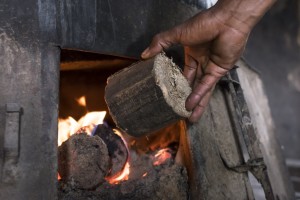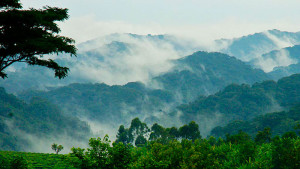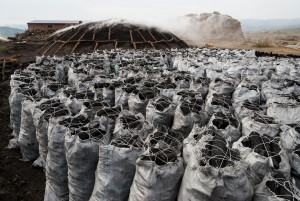Charting a Course from Charcoal to Clean Energy
Jul 28th, 2016 | By admin | Category: Energy and Carbon EmissionsBy Suzanne York.
Forests play a major role in maintaining life on Earth. Yet with some exceptions (see India Plants 50 Million Trees in One Day), deforestation continues, with seemingly little regard for the consequences.The recently released UN Food and Agriculture Organization’s (FAO) State of the World’s Forests (Sofo) report found that, amongst tropical countries, there occurred a net forest loss of seven million hectares per year between the years of 2000 and 2010. It noted that agriculture is still the most significant driver of global deforestation. Yet much of the forest loss, especially in Africa, is also driven by a need for fuel.
A clean energy revolution may be taking place in many countries, but for much of the world, people still rely on wood fuels (namely charcoal and firewood) for producing energy. According to the World Health Organization, approximately 3 billion people use open fires and simple, inefficient stoves to cook and heat their homes.
The FAO has stated that in Africa, the production of charcoal has doubled in the past two decades and accounts for over 60 percent of the world’s total, driven by rapid urbanization. The New York Times reported that, according to the UN, “As Africa’s population is expected to swell and urbanize at an even faster rate over the next decades, the continent’s demand for charcoal is likely to double or triple by 2050” (emphasis added).
More than 90 percent of rural households in Sub-Saharan Africa depend on firewood or charcoal in Africa as a primary energy source. Charcoal is a big business, and the impact on the environment is devastating from deforestation, biodiversity loss and increased carbon emissions. And household pollution from cookstoves is a major threat to public health, as toxic pollutants are released into the air. As women are traditionally the primary providers collecting fuel and cooking for their families, they are impacted the most (especially rural, poor women).
Social Enterprise and Sustainability
In Kenya, 125,000 acres of trees are cut for charcoal every year (the equivalent of 15,000 soccer fields). Nearly 9 million households in Kenya use charcoal every day. The Global Alliance for Clean Cookstoves estimates over 36 million Kenyans are affected by household air pollution (HAP), with over 15,000 deaths in Kenya annually directly related to HAP.
Disturbed at seeing how pollution threated his mother’s health, Tom Osborn, a young entrepreneur, co-founded GreenChar. It is a social enterprise that sells smokeless charcoal briquettes made from sugarcane waste and other agricultural wastes, and also distributes clean cookstoves to the local population. It is long lasting and low cost and can save families $200/year.

An example of Greenchar’s non-carbonized Long Burn briquettes [photo credit: http://www.greenchar.co.ke]
At the Women Deliver conference this past May, Osborn talked about how GreenChar empowers women by placing them at the center of the solution – throughout the sourcing, production, distribution stages. High selling entrepreneurs were twice as likely to be women (selling more than 8 stoves), and women outsell men cook stove sellers by nearly 3 to 1. Ultimately, Tom said, “Increasing access to women’s property and land rights is crucial to increasing their access to clean energy solutions.”
Local Solutions
Park officials at Virunga National Park in the Democratic Republic of the Congo have also been working on ways to bring clean energy to the local population to end the destruction of forests for charcoal. Some 4 million people live around the park, many of whom live in extreme poverty and are reliant on charcoal for survival. Eastern Congo is endowed with vast hydro resources, and the park is tapping into this by bringing electricity to people who experience severe power shortages amidst too many other deprivations.
The need is obvious. According to World Wildlife Fund, the nearby city of Goma alone consumes above 105,000 tons of charcoal every year, at a total cost of about US$55.9 million. Surveys spearheaded by park authorities showed that off-grid hydroelectricity plants could generate more than 100 megawatts of energy, which is 25 times more power than the city of Goma – home to over 1 million people – currently receives.
Two hydropower plants are now operational and producing clean electricity (one generating 13.6 megawatts and a second generating .4 megawatts), with more set to come.

Water from the glaciated peaks of the Rwenzori Mountains of Virunga National Park is being used to generate electricity. (Photo credit: Fiverlocker/Creative Commons)
‘Empower, Inform, Protect’
The above are just two examples of efforts happening on the ground that will hopefully stem the illegal trade of charcoal. As the world strives to meet the Sustainable Development Goals, efforts to reach SDG 15 – “Protect, restore and promote sustainable use of terrestrial ecosystems, sustainably manage forests, combat desertification, and halt and reverse land degradation and halt biodiversity loss” – will need to encompass an integrated approach. Until people’s basic needs are met, they will do whatever it takes to survive, even cutting down forests that sustain so much life.
In the words of Wangari Maathai, “You cannot protect the environment unless you empower people, you inform them, and you help them understand that these resources are their own, that they must protect them.”
Suzanne York is Project Director of Transition Earth.

